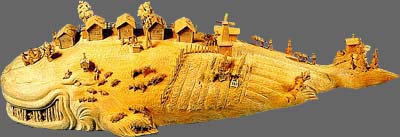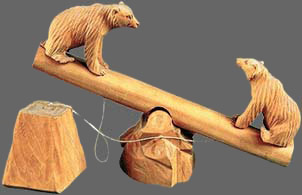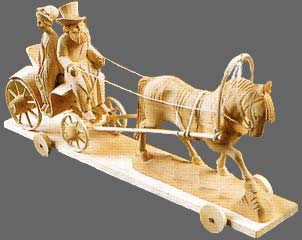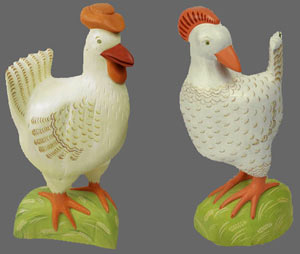|  ames and toys are as old as anything in the human world.
They emerged at the dawn of human civilization and were
important instruments in the processes of socialization,
upbringing, development, and education of human beings.
The ancient toys were typically made of the two materials
most common in Russia, that is, wood and clay.
ames and toys are as old as anything in the human world.
They emerged at the dawn of human civilization and were
important instruments in the processes of socialization,
upbringing, development, and education of human beings.
The ancient toys were typically made of the two materials
most common in Russia, that is, wood and clay.
These days, hundreds and even thousands
years later, we encountering the types of toys that emerged
ancient times. The more developed a civilization is in material
terms, the more sophisticated are the toys produced by it.
The centers of traditional manufacture typically coincided
with the centers of traditional earthenware crafts and wood
working trades. The craftsmen manufactured various utensils
and other useful articles in the workshops while women and
children made toys from the same materials. In the distant
past toys had many uses, magical, domestic, and artistic.
The magical use of toys in rituals was of a primary importance
at the earliest stages of human civilizations. The artistic
attributes were of primary importance, too.

Pilipp Yeroshkin. "How the Mice buried the
Cat"
19th century
|
The public interest
in toys typical for differ nations and times has been rapidly
growing in recent period. The ever-accelerating tempo of
contemporary life makes the humans realize that their childhood
experiences and impressions have shaped the most intimate
components of their personalities. The contemporary Russian
culture is unique that it simultaneously sustains age-old
folk and crafts and modem art trends, which stem from and
develop folk traditions. Craftsmen are
manufacturing folk toys in traditional styles and materials
while the best custom-made toys car regarded as masterpieces
of modern art.
The wooden toys are very ancient
in origin. The traditional centers of the toy trade in Russia
are the Northern Russia, the Volga region, and the Moscow
region.The craftsmen of the village of Bogorodskoe near
Moscow were making wooden toys from rimes immemorial though
they typically did not decorate them with painting. The
village was on the land of the Troitse-Sergiev Monastery
and there obviously was a ongoing cooperation between the
craftsmen

Alexander.Zinin. "The Marvellous Fish-Whale". 1947
(after the tale of P.Yershov)
|
Traditionally the
toy-making trade was practices by whole families in the
village of Bogorodskoe. Children were trained in woodworking
skills from an early age. Each family tended to specialize
in making a certain type of toys. For instance, K.Boblovkin
carved bird figurines while Y. Boblovkin carved figurines
of various animals. P.Chushkin carved human dolls and M.Pronin
carved carriages driven by teams of three horses.
The Bogorodskoe toys can be classified into three types
each of which represents a certain stage in development
of the art of Russian wooden sculpture through the centuries.
The first type includes the traditional
toy consisting of two rocking figurines of blacksmiths balanced
on two opposite ends of a plank. The toy represents the
early stage of sculpture development, the figurines are
primitively modeled, the shapes are roughly fashioned and
the figures are quite flat. These toys are very common as
they are largely easy to manufacture.
The second type includes the toys
made of triangular blocks of wood. The toy shapes are reminiscent
of the pre-Christian Russian wooden sculpture. The sculpture
style of the toy "noble ladies" and "cavalrymen"
is similar to that of the ancient wooden idols found near
Novgorod. The nameless Novgorod wood carver aimed at revealing
the inherent nature of wood in his sculptured shape. He
made a creative use of the twigs, branches, etc. of the
tree trunk he was carving. The modeling of the Bogorodskoe
wooden figurines also depends on the wood blank properties
which are more important to the carver than any preconceived
artistic concept.

"Two bears". 1936
|
The third
type includes the toys whose fully developed sculptural
forms are rooted in the Moscow art style of the second half
of the fourteen-century. The reason is that until they reach
a certain age children prefer playing with archaic toys
than with more sophisticated ones. When one traces the evolution
of these three toy types with time one sees that the primitive
"blacksmith" toys remain popular even at the present
time. Here we encounter one of the oldest and most fundamental
functions of the folk art as it fulfils its educational
mission. The contemporary child easily relates to the primitive
types of folk art that arose at the dawn of humanity.
The Bogorodskoe toys are manufactured
of various kinds of wood, such as lime tree, ash tree, or
willow tree.The primary tools used by a toy maker are a
hatchet, a special knife with a short curved blade and a
wooden handle, and a set of round cutters of different sizes.
A wooden blank is first cut to size with a hatchet and the
remaining work is completed mostly with the knife. While
working the craftsman is typically sitting on a low bench
holding the wood blank on his lap. The surface of a semi-finished
toy is finely carved to represent the fur of a bear, the
feathers of a bird, or the mane a horse. The toys are distinguished
not only by the skilful carving but also by highly original
mechanisms. The toys have moving parts, they may counter
balanced and activated by hidden springs pushbuttons, and
so on.

M.Barinov. "The carriage". 1979
|
With time there was a gradual renewal
of the interest in the toys, in particular, toys from the
rural regions. In the Soviet period that started in 1917
and ended in the late eighties the handmade toy trade prospered
largely at the centers of folk arts and crafts. The village
of Bogorodskoe in the Moscow region became a major center
of manufacturing of the carved wooden toys. The "Bogorodskoe
Wood Carver" cooperative was set up in the village
in 1923 and the school of wood carving art was established
there where the best craftsmen in whose families the skills
were passed on from one generation to another trained the
students. The Bogorodskoe wood carving traditions, style,
and motifs were preserved in their totality as an art. The
Soviet government allowed the trade to live and develop
for several decades because the folk art was rooted in the
peasant environment. The Bogorodskoe toys depicting wild
animals, cattle, and scenes of rural life presented no ideological
threat to the regime. Such toys as "Blacksmiths",
"Tea drinkers", "Cattle herd", "Three
horses","Firewood sawing", etc. are still
manufactured the Bogorodskoe craftsmen.

T.Phlenova
"Chicken and cockerel". 2004 |
In the Soviet period the most popular
Bogorodskoe toys were the so-called "motion" toys
(operated by balances and counterbalances, springs strings,
etc.) and decorative figurines. New toy motifs and images
taken from classical Russian literature, fairly tales and
everyday life were added the traditional ones. Starting
from 1960s the majority of toys involved an image of the
bear who is the principal character in many Russian legends
fairy tales, and folk songs. In ancient Russian mythology
bear was regarded as a special beast which was the closest
in character to humans was not accidental that the most
popular Bogorodskoe toy known as the "blacksmiths"
features the counterbalanced figures of a bear and a man
sitting alternately an anvil with a hammer. The modern Bogorodskoe
toys often feature the bear "human" situations.
After the Russian cosmonaut became the first man to make
a space flight 1961 the Bogorodskoe craftsmen made a toy
presenting a bear navigating a spaceship. In more recent
Bogorodskoe toys bears are featured a sawing firewood, operating
a computer, playing chess, piano, cello, or a balalaika.
The contemporary Bogorodskoe toy makers M.Smirnov, M.Dvornikov,
M.Orlov, and S.Pautov are still employing the traditional
wood carving style and use the old motion mechanisms
|